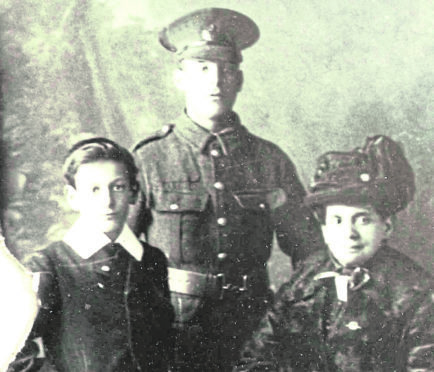Just before he died in his early 90s, my grandfather shot bolt upright in his hospital bed, gripped my arms and cried out repeatedly, “I can still see their faces. I can still see their faces.”
His faculties might have been slowly crumbling all around him like bits falling off a proud and dignified statue, but this memory in particular was as sharp as barbed wire in no man’s land.
He was beseeching, almost imploring me to help him wipe it away.
I was helpless, of course, It is vivid for me after more than a quarter of a century.
I knew only too well what was upsetting him–these demons he could never shake off. The horror from 75 years earlier was being were being run and re-run by his brain like a computer game on a loop.
Former Corporal Jack Knight, you see, was a machine gunner in The Great War.
He survived and came home when millions didn’t. He was in one piece, but he brought back obvious physical scars like the tiny black shrapnel fragments which moved around his legs for years. He cloaked any lasting psychological damage and this remained hidden from the view of his adoring grandchildren as we grew up with this wonderful caring, gentle old man.
It was like that then. Stiff upper lip and all that, and he worked as an electrical engineer until retirement.
As a society we are now trying to embrace the special needs of those suffering from conflict, including post traumatic stress disorder, but only weeks ago the dangers of suicide and other mental problems today among combat-stressed veterans was raised again by an Aberdeen councillor and serviceman, who urged more to be done.
It came as Granite City pledged to make itself the friendliest city for veterans in Scotland. As we approach this historic Armistice Day, it shows the same psychological horrors are still re-emerging today and posing new challenges for us.
Jack just seemed to get on with the rest of his life and kept any demons hidden.
He bought me my first suit as a teenager. All I had to worry about was picking a suit, but when Jack was my age he was fighting for his life.
Is there not a single family in Scotland which does not have a similar story to tell?
Such was the scale of the conflict that virtually every family was affected in one way or another. It is a common and deep bond that we share across the UK.
Jack volunteered for active service the year before conscription came in.
Earlier, he won a book prize at Sunday school. After basic training, he boarded a troop ship in Liverpool in July 1915. Within two weeks he had landed at Suvla Bay and was thrown into the horror of the Gallipoli campaign against Turkish forces. I read one report which recorded that his battle group lost 350 men–dead, wounded or missing–in the opening few days. The former Sunday school prize-winner came back with a “14-15 Star”–a medal only awarded in those years for service in a combat zone.
He was 17 when he landed at Gallipoli.
That sounds incredible today. How could that happen?
These were different times: Jack was a volunteer and a blind eye was often turned by recruiting sergeants to age restrictions as they were under pressure to keep numbers up. They were also desperate for reinforcements to rescue troops who landed earlier in the heroic but disastrous Gallipoli campaign, but remained pinned down by the enemy.
I look at boyish Jack, his little brother and mother posing in the picture. It was a popular thing to do at the time before going off to war. I look into my great-grandmother’s uneasy eyes and wonder what she was going through emotionally, and how she could let him go.
“Your Country Needs You” mania was sweeping them along.
Years later, we blood-thirsty grandchildren would beg him for gory war stories. When he did say something, it was never about self-glorification or gung-ho.
Terrible random memories would emerge which illustrated the waste and suffering.
He remembered edging past bodies stacked on top of each other in grotesque makeshift “walls” of dead, as the living edged towards frontline fighting positions. He remembered huddling in a trench trying desperately to make spiritual contact with his father (who died a few months earlier) to protect him–after being ordered to fix bayonets for a charge. He once thought he saw his father standing shoulder to shoulder with him under fire.
This was not about glorifying it–he was terrified like everyone else.
Usually, grandmother would cut him short with, “Shush, you’ll give them nightmares.” What about his nightmares?
He was lucky, he came back,
In my Aberdeen garden, there is a big wall and behind it is a large cemetery. Among the graves are the memorials to those who did not make it–more than 50 men who died in The Great War. One can hardly imagine the cries of anguish which rang out here from scores of loved ones who said their goodbyes to young lives crushed before they flowered.
On the opposite side of the cemetery wall by my garden shed lie the remains of a young man who died at the age of 21 from his wounds, but a few years after the armistice. I often think of him when I sit in my garden. He must have been around the same age as Jack when he fought.
Nearby is a memorial for two brothers and two sons-in-law from the same family killed in action, Just stop and think about that- four from one family. Another records two brothers killed in action within months.
Many of those who survived lived with the terror for years, and today’s combatants still do.
I don’t know how my dear loving grandfather coped. I wish I had found the time to ask him.











